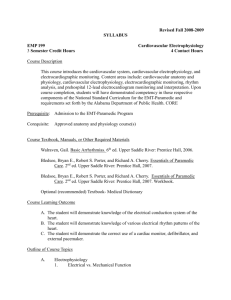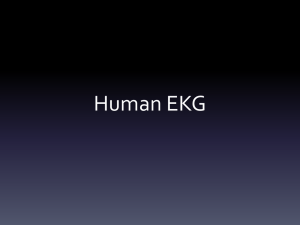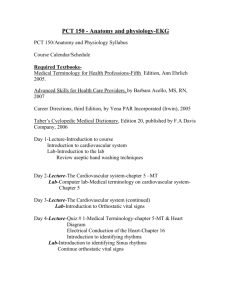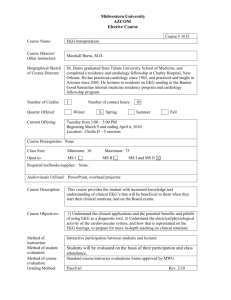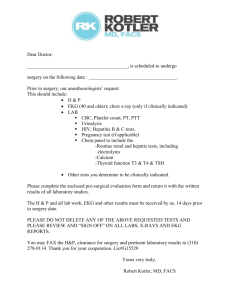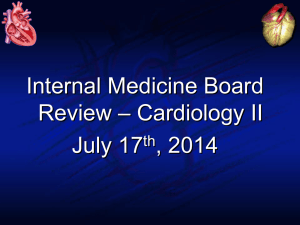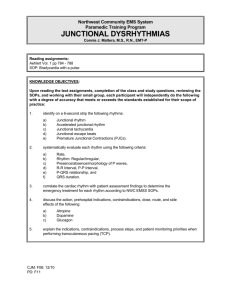DOC
advertisement
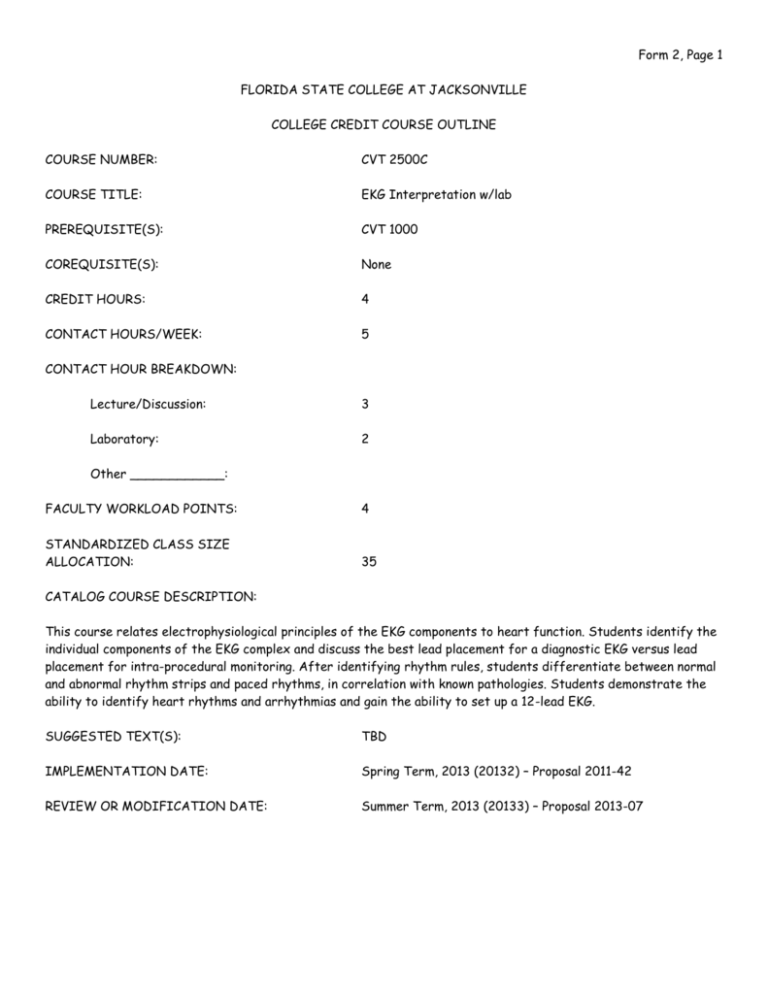
Form 2, Page 1 FLORIDA STATE COLLEGE AT JACKSONVILLE COLLEGE CREDIT COURSE OUTLINE COURSE NUMBER: CVT 2500C COURSE TITLE: EKG Interpretation w/lab PREREQUISITE(S): CVT 1000 COREQUISITE(S): None CREDIT HOURS: 4 CONTACT HOURS/WEEK: 5 CONTACT HOUR BREAKDOWN: Lecture/Discussion: 3 Laboratory: 2 Other ____________: FACULTY WORKLOAD POINTS: 4 STANDARDIZED CLASS SIZE ALLOCATION: 35 CATALOG COURSE DESCRIPTION: This course relates electrophysiological principles of the EKG components to heart function. Students identify the individual components of the EKG complex and discuss the best lead placement for a diagnostic EKG versus lead placement for intra-procedural monitoring. After identifying rhythm rules, students differentiate between normal and abnormal rhythm strips and paced rhythms, in correlation with known pathologies. Students demonstrate the ability to identify heart rhythms and arrhythmias and gain the ability to set up a 12-lead EKG. SUGGESTED TEXT(S): TBD IMPLEMENTATION DATE: Spring Term, 2013 (20132) – Proposal 2011-42 REVIEW OR MODIFICATION DATE: Summer Term, 2013 (20133) – Proposal 2013-07 Form 2, Page 2 COURSE TOPICS I. Demonstrate knowledge of the correlation of the electrical function of the heart to mechanical function of the heart. A. B. C. II. III. 8 Mechanical: 1. RA 2. RV 3. PA 4. LA 5. LV Electrical: 1. SA Node 2. AV Node 3. Bundle of His 4. Bundle branches 5. Purkinje Fibers Electrophysiology 1. Electrical conduction vs Mechanical function 2. Sodium pump 3. Polarization and depolarization Discuss and be able to identify each portion of the EKG waveform with normal vs. abnormal measurements. A. B. C. D. CONTACT HOURS __PER TOPIC__ 45 lecture hours 30 lab hours 4 Waves and measurements. Graph paper and values Cardiac cycle Artifact and interference Discuss and be able to differentiate between Sinus, Atrial, Junctional, and Ventricular Rhythms, Heart Blocks, and paced rhythms. 10 A. B. Sinus Rhythms: 1. Normal sinus 2. Sinus bradycardia 3. Sinus tachycardia 4. Sinus arrhythmia Atrial Rhythms: 1. Premature Atrial Contractions 2. Atrial tachycardia 3. Atrial fibrillation 4. Atrial flutter 5. Wandering pacemaker 6. Ectopic beats Form 2, Page 3 COURSE TOPICS C. D. E. CONTACT HOURS __PER TOPIC__ Ventricular Rhythms: 1. Premature Ventricular Contractions 2. Ventricular tachycardia 3. Ventricular fibrillation 4. Ventricular flutter 5. Unifocal vs multifocal PVC’s 6. Runs and couplets (Bigeminy, trigeminy) 7. Asystole Heart Blocks: 1. First degree 2. Second degree a. Type I (Wenckebach) b. Type II a. Third degree (Complete heart block) Junctional Rhythms: 1. Junctional pacemaker 2. Junctional P-wave 3. Premature junctional contractions 4. Junctional escape rhythm 5. Junctional tachycardia 6. Accelerated junctional rhythm 7. Supraventricular tachycardia IV. Discuss and be able to correlate arrhythmias to cardiac pathologies. 4 V. Discuss and be able to perform 12-lead EKG. A. Myocardial Infarction and Ischemia B. Bundle Branch blocks 4 VI. Discuss regular stress testing using various accepted protocols. 4 VII. Discuss ambulatory ECG (holter monitoring, event monitoring) 3 VIII. Discuss stress echo/pharmacological stress echo. 2 IX. Discuss nuclear stress testing. 2 X. Discuss and be able to differentiate between artifact, interference, noise versus arrhythmias. 2 XI. Demonstrate knowledge of how to troubleshoot EKG lead issues. 2 XII. Lab 30 Form 2, Page 4 PROGRAM TITLE: Cardiovascular Technology COURSE TITLE: EKG Interpretation w/lab CIP NUMBER: 02.0 DEMONSTRATE THE ABILITY TO COMMUNICATE AND USE INTERPERSONAL SKILLS EFFECTIVELY. -- The student will be able to: 02.01 02.02 02.03 02.04 02.05 02.06 02.07 02.08 02.09 02.10 02.11 02.12 06.0 1351090100 Develop basic speaking and active listening skills. Develop basic observational skills and related documentation strategies in written and oral form. Identify characteristics of successful and unsuccessful communication including barriers. Respond to verbal and non-verbal cues. Compose written communication using correct spelling, grammar, formatting and confidentiality. Use appropriate medical terminology and abbreviations. Recognize the importance of courtesy and respect for patients and other healthcare workers and maintain good interpersonal relationships. Recognize the importance of patient/client educations regarding healthcare. Adapt communication skills to varied levels of understanding and cultural orientation including diverse age, cultural, economic, ethnic and religious groups. Recognize elements of communication using a sender-receiver model. Distinguish between and report subjective and objective information. Report relevant information in order of occurrence. RECOGNIZE AND RESPOND TO EMERGENCY SITUATIONS.--The student will be able to: 06.01 Monitor and record vital signs. 06.03 Obtain and maintain training or certification on cardiopulmonary resuscitation (CPR), automated external defibrillator (AED), foreign body airway obstruction (FBAO) and first aid. 08.0 DEMONSTRATE AN UNDERSTANDING OF INFORMATION TECHNOLOGY APPLICATIONS IN HEALTHCARE.-- The student will be able to: 08.01 08.02 08.03 08.04 08.05 11.0 Describe the uses of computers in healthcare. . Define terms and demonstrate basic computer skills. Recognize technology applications in healthcare. Interpret information from electronic medical documents. Identify methods of communication to access and distribute data such as fax, e-mail and internet. APPLY BASIC MATH AND SCIENCE SKILLS. --The student will be able to: 11.01 11.02 11.03 11.04 11.05 11.06 11.07 11.08 Draw, read, and report on graphs, charts and tables. Measure time, temperature, distance, capacity, and mass/weight. Make and use measurements in both traditional and metric units. Make estimations and approximations and judge the reasonableness of the result. Convert from regular to 24 hour time. Demonstrate ability to evaluate and draw conclusions. Organize and communicate the results obtained by observation and experimentation. Ask appropriate scientific questions and recognize what is involved in experimental approaches to the solution of such questions. Form 2, Page 5 PROGRAM TITLE: Cardiovascular Technology COURSE TITLE: EKG Interpretation w/lab CIP NUMBER: 1351090100 11.09 13.0 IDENTIFY THE ANATOMIC STRUCTURE AND FUNCTION OF BODY SYSTEMS IN RELATION TO CARDIOVASCULAR DISEASE AND STUDIES. – The student will be able to: 13.01 13.02 13.03 13.0 Observe acceptable safety practices in cardiovascular instrumentation. Demonstrate knowledge of quality assurance as it relates to imaging equipment, film quality, etc. Implement appropriate JCAHO patient safety goals. USE BASIC MEDICAL ELECTRONICS AND MEDICAL INSTRUMENTATION. – The student will be able to: 17.01 17.02 17.03 17.04 18.0 Describe human anatomy and physiology with emphasis on the cardiovascular and pulmonary systems. Identify normal and abnormal data obtained from medical tests. Describe basic pathological conditions of the cardiovascular and pulmonary systems. PRACTICE SAFETY AND QUALITY ASSURANCE. – The student will be able to: 15.01 15.02 15.03 17.0 Calculate ratios. Identify the duties related to electronic monitoring and diagnostic testing of patient. Demonstrate computer literacy skills as applied to cardiovascular practice. Operate equipment used in diagnostic testing and physiological monitoring of patients. Set up, calibrate and operate selected equipment in the cardiovascular laboratory. DESCRIBE THE ROLE OF THE CARDIOVASCULAR TECHNOLOGIST IN CATASTROPHIC EVENT MANAGEMENT. – The student will be able to: 18.02 18.03 18.04 Respond to simulated emergency care situations encountered in a cardiovascular department. Identify the components of the defibrillator. Cite the indications for cardiac defibrillation and cardioversion. Florida State College At Jacksonville Course Learning Outcomes & Assessment NOTE: Use either the Tab key or mouse click to move from field to field. The box will expand to accommodate your entry. Section 1 SEMESTER CREDIT HOURS (CC): 4 CONTACT HOURS (NCC): COURSE PREFIX AND NUMBER: CVT2500C COURSE TITLE: EKG Interpretation w/lab Section 2 TYPE OF COURSE: (Click on the box to check all that apply) AA Elective AS Required Professional Course College Prep AS Professional Elective AAS Required Professional Course Technical Certificate Other PSAV Apprenticeship General Education: (For General Education courses, you must also complete Section 3 and Section 7) Section 3 (If applicable) INDICATE BELOW THE DISCIPLINE AREA FOR GENERAL EDUCATION COURSES: Communications Social & Behavioral Sciences Natural Sciences Humanities Mathematics Section 4 INTELLECTUAL COMPETENCIES: Reading Speaking Critical Analysis Writing Listening Information Literacy Quantitative Skills Ethical Judgment Scientific Method of Inquiry Working Collaboratively Section 5 STATE GENERAL EDUCATION LEARNING OUTCOME AREA Critical Communication Scientific and Quantitative Reasoning Thinking Information Global Sociocultural Responsibility Literacy Section 6 LEARNING OUTCOMES Demonstrate knowledge of the correlation of the electrical function of 2 the heart to mechanical function of the heart. Discuss and be able to identify each 3portion of the EKG waveform with normal vs. abnormal measurements. Type of Outcome: Gen. Ed, Program, Course Program Program METHOD OF ASSESSMENT Observation, online exercises/quizzes, clinical application, projects, or written papers. Observation, online exercises/quizzes, clinical application, projects, or written papers. Section 6 (continued) LEARNING OUTCOMES Discuss and be able to differentiate between Sinus, Atrial, Junctional, and 4 Ventricular Rhythms, Heart Blocks, and paced rhythms. Discuss and be able to correlate 5 arrhythmias to cardiac pathologies. Discuss and be able to perform 12-lead 6 EKG. Discuss and be able to differentiate 7between artifact, interference, noise versus arrhythmias. Demonstrate knowledge of how to 8 troubleshoot EKG lead issues. Type of Outcome: Gen. Ed, Program, Course Program Program Program METHOD OF ASSESSMENT Observation, online exercises/quizzes, clinical application, projects, or written papers. Observation, online exercises/quizzes, clinical application, projects, or written papers. Observation, online exercises/quizzes, clinical application, projects, or written papers. Program Observation, online exercises/quizzes, clinical application, projects, or written papers. Program Observation, online exercises/quizzes, clinical application, projects, or written papers. Section 7 Name of Person Completing This Form: Christie Jordan Date: 02/04/2013

